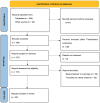Proton Radiation Therapy: A Systematic Review of Treatment-Related Side Effects and Toxicities
- PMID: 39456752
- PMCID: PMC11506991
- DOI: 10.3390/ijms252010969
Proton Radiation Therapy: A Systematic Review of Treatment-Related Side Effects and Toxicities
Abstract
Cancer is the second leading cause of death worldwide. Around half of all cancer patients undergo some type of radiation therapy throughout the course of their treatment. Photon radiation remains (RT) the most widely utilized modality of radiotherapy despite recent advancements in proton radiation therapy (PBT). PBT makes use of the particle's biological property known as the Bragg peak to better spare healthy tissue from radiation damage, with data to support that this treatment modality is less toxic than photon RT. Hence, proton radiation dosimetry looks better compared to photon dosimetry; however, due to proton-specific uncertainties, unexpected acute, subacute, and long-term toxicities can be encountered. Reported neurotoxicity resulting from proton radiation treatments include radiation necrosis, moyamoya syndrome, neurosensory toxicities, brain edema, neuromuscular toxicities, and neurocognitive toxicities. Pulmonary toxicities include pneumonitis and fibrosis, pleural effusions, and bronchial toxicities. Pericarditis, pericardial effusions, and atrial fibrillations are among the cardiac toxicities related to proton therapy. Gastrointestinal and hematological toxicities are also found in the literature. Genitourinary toxicities include urinary and reproductive-related toxicities. Osteological, oral, endocrine, and skin toxicities have also been reported. The side effects will be comparable to the ones following photon RT, nonetheless at an expected lower incidence. The toxicities collected mainly from case reports and clinical trials are described based on the organs affected and functions altered.
Keywords: cardiac toxicity; endocrine toxicity; gastrointestinal toxicity; hematological toxicity; neurotoxicity; oral toxicity; osteological toxicity; proton radiation therapy; pulmonary toxicity; urological toxicity.
Conflict of interest statement
The authors declare no conflicts of interest.
Figures
References
-
- International Agency for Research on Cancer Estimated Number of New Cases in 2020, World, Both Sexes, All Ages (excl. NMSC) [(accessed on 6 March 2023)]; Available online: https://gco.iarc.fr/today/online-analysis-table?v=2020&mode=cancer&mode_....
-
- World Cancer Research Fund International Worldwide Cancer Data. [(accessed on 6 March 2023)]. Available online: https://www.wcrf.org/cancer-trends/worldwide-cancer-data/
-
- Paganetti H., Van Luijk P. Seminars in Radiation Oncology. Elsevier; Amsterdam, The Netherlands: 2013. Biological considerations when comparing proton therapy with photon therapy; pp. 77–87. - PubMed
Publication types
MeSH terms
Grants and funding
LinkOut - more resources
Full Text Sources
Medical



